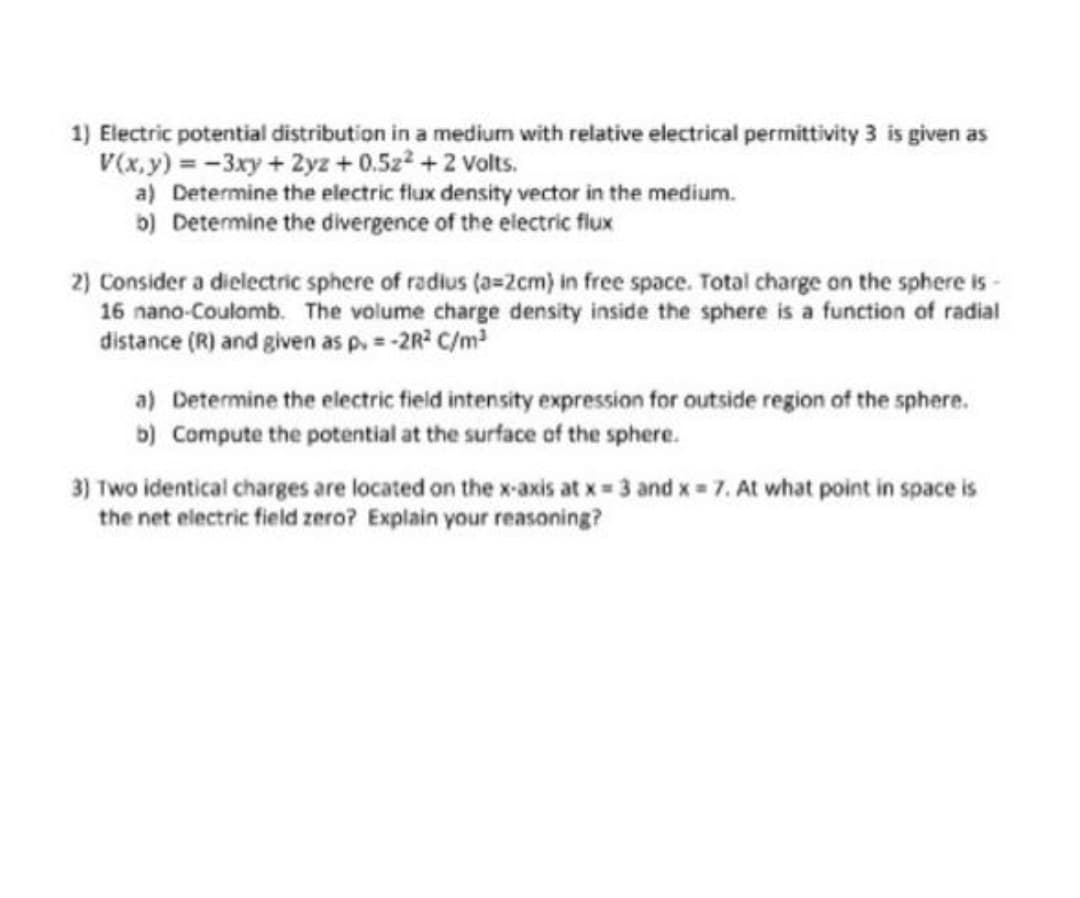1) Electric potential distribution in a medium with relative electrical permittivity 3 is given as V(x,y) -3xy+ Zyz +0.5z2+2 Volts. a) Determine the electric flux density vector in the medium. b) Determine the divergence of the electric flux
1) Electric potential distribution in a medium with relative electrical permittivity 3 is given as V(x,y) -3xy+ Zyz +0.5z2+2 Volts. a) Determine the electric flux density vector in the medium. b) Determine the divergence of the electric flux
Introductory Circuit Analysis (13th Edition)
13th Edition
ISBN:9780133923605
Author:Robert L. Boylestad
Publisher:Robert L. Boylestad
Chapter1: Introduction
Section: Chapter Questions
Problem 1P: Visit your local library (at school or home) and describe the extent to which it provides literature...
Related questions
Question

Transcribed Image Text:1) Electric potential distribution in a medium with relative electrical permittivity 3 is given as
V(x.y) = -3xy+ 2yz + 0.5z2 +2 Volts.
a) Determine the electric flux density vector in the medium.
b) Determine the divergence of the electric flux
2) Consider a dielectric sphere of radius (a=2cm) in free space. Total charge on the sphere is-
16 nano-Coulomb. The volume charge density inside the sphere is a function of radial
distance (R) and given as p,= -2R C/m
a) Determine the electric field intensity expression for outside region of the sphere.
b) Compute the potential at the surface of the sphere.
3) Two identical charges are located on the x-axis at x 3 and x 7. At what point in space is
the net electric field zero? Explain your reasoning?
Expert Solution
This question has been solved!
Explore an expertly crafted, step-by-step solution for a thorough understanding of key concepts.
Step by step
Solved in 2 steps with 1 images

Knowledge Booster
Learn more about
Need a deep-dive on the concept behind this application? Look no further. Learn more about this topic, electrical-engineering and related others by exploring similar questions and additional content below.Recommended textbooks for you

Introductory Circuit Analysis (13th Edition)
Electrical Engineering
ISBN:
9780133923605
Author:
Robert L. Boylestad
Publisher:
PEARSON

Delmar's Standard Textbook Of Electricity
Electrical Engineering
ISBN:
9781337900348
Author:
Stephen L. Herman
Publisher:
Cengage Learning

Programmable Logic Controllers
Electrical Engineering
ISBN:
9780073373843
Author:
Frank D. Petruzella
Publisher:
McGraw-Hill Education

Introductory Circuit Analysis (13th Edition)
Electrical Engineering
ISBN:
9780133923605
Author:
Robert L. Boylestad
Publisher:
PEARSON

Delmar's Standard Textbook Of Electricity
Electrical Engineering
ISBN:
9781337900348
Author:
Stephen L. Herman
Publisher:
Cengage Learning

Programmable Logic Controllers
Electrical Engineering
ISBN:
9780073373843
Author:
Frank D. Petruzella
Publisher:
McGraw-Hill Education

Fundamentals of Electric Circuits
Electrical Engineering
ISBN:
9780078028229
Author:
Charles K Alexander, Matthew Sadiku
Publisher:
McGraw-Hill Education

Electric Circuits. (11th Edition)
Electrical Engineering
ISBN:
9780134746968
Author:
James W. Nilsson, Susan Riedel
Publisher:
PEARSON

Engineering Electromagnetics
Electrical Engineering
ISBN:
9780078028151
Author:
Hayt, William H. (william Hart), Jr, BUCK, John A.
Publisher:
Mcgraw-hill Education,